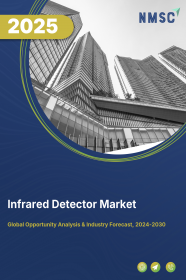Silicon Photonics Market by Component (Lasers, Modulators, and Photo Detectors), by Product (Transceivers, Variable Optical Attenuators, Switches, Cables, and Sensors), by Waveguide (400-1500 NM, 1310-1550 NM, and 900-7000 NM), and by Application (Automotive, Data Centers & High-Performance Computing, Telecommunication, Defense & Aerospace, Medical & Life Science, and Others)– Global Opportunity Analysis and Industry Forecast 2025–2030
Silicon Photonics Market Overview
The global Silicon Photonics Market size was valued at USD 2.06 billion in 2024 and it is projected to reach USD 11.15 billion by 2030 with a CAGR of 27.3% from 2025-2030.
The market is driven by factors including growing healthcare industry along with rising expenditure towards aerospace and defense industry and expanding automotive electronics industry. However, the market is restricted by the outrageous development cost.
On the other hand, artificial intelligence in silicon photonics offers growth prospects for the market in the future years. Market leaders such as Cisco Systems and Global Foundries are making efforts to sustain the market dominance. These innovations are developing future growth prospects for the next few years.
Emerging Healthcare Sector Drives Silicon Photonics Adoption
The burgeoning healthcare sector significantly propels the market by enabling advancements in medical imaging, biosensing, and patient monitoring systems. These photonics offers high-speed data transmission and miniaturization, enhancing the precision and efficiency of healthcare devices like optical coherence tomography (OCT) systems and wearable diagnostics.
According to the World Bank, global healthcare expenditure per capita increased by 35.7% from USD 1,207 in 2014 to USD 1,638 in 2023, reflecting growing investments in advanced medical technologies. This surge in spending drives demand for high-performance solutions that handle large data volumes for real-time diagnostics and telemedicine, positioning silicon photonics as a critical enabler in meeting the evolving needs of modern healthcare applications.
Rising Aerospace and Defense Expenditure Fuels the Market Growth
Increasing investments in aerospace and defense are a major driver of the silicon photonics market demand, fueled by the need for high-speed, secure communication systems and advanced data processing technologies. It provides low-power, high-bandwidth solutions essential for next-generation avionics, satellite communications, and defense applications like radar and secure data links.
The World Bank reports that global military expenditure grew by 47.9%, from USD 1.65 trillion in 2016 to USD 2.44 trillion in 2023, highlighting the sector’s focus on cutting-edge technologies. These investments underscore the demand for silicon photonics to support mission-critical systems, driving market growth as governments and private entities prioritize enhanced military capabilities and secure communications infrastructure.
Increasing Automotive Electronics Industry Drives Silicon Photonics Market Growth
The rapidly growing automotive electronics industry accelerates the market by leveraging the technology for high-bandwidth connectivity, sensor integration, and autonomous driving systems. It enables vehicle-to-everything (V2X) communication, LiDAR for advanced driver-assistance systems (ADAS), and in-vehicle networks requiring low-latency data transfer.
According to the NMSC, the automotive electronics market is projected to grow from USD 231.12 billion in 2021 to USD 441.20 billion by 2030, reflecting the increasing integration of sophisticated electronics in vehicles. This expansion drives demand for silicon photonics to support high-speed, reliable communication and sensing solutions, fostering innovation in smart and autonomous vehicle technologies.
High Development Costs Hinders the Silicon Photonics Market Expansion
The market faces significant challenges due to high research and development costs and the complexity of integrating photonic components with existing Complementary Metal-Oxide-Semiconductor (CMOS) processes. These technical hurdles result in lower manufacturing yields and elevated production costs compared to traditional semiconductor technologies.
The need for specialized fabrication techniques and advanced packaging solutions further increases expenses, limiting adoption, particularly among smaller players. Addressing these challenges requires ongoing investments in process optimization and standardized manufacturing protocols to achieve cost efficiencies.
Adoption of Artificial Intelligence in Silicon Photonics Presents Future Market Growth Opportunities
The incorporation of artificial intelligence (AI) into silicon photonics presents transformative opportunities for market growth by enhancing data processing capabilities and system efficiency. AI algorithms optimize photonic device designs, enabling faster data transmission, improved signal-to-noise ratios, and reduced latency in applications like hyperscale data centers and AI accelerators.
In June 2024, Samsung Electronics announced plans to launch an AI-integrated silicon photonics solution by 2027, utilizing a 1.4 nm process and BackSide Power Delivery Network to advance semiconductor foundry services and packaging for AI applications. This development highlights the potential for AI-driven photonics to revolutionize high-performance computing and open new market avenues.
Additionally, posts on X in April 2025 noted iPronics’ launch of a silicon photonics optical circuit switch tailored for AI data centers, emphasizing the technology’s role in scalable, energy-efficient AI hardware.
Furthermore, in January 2025, InnoLight announced plans to ship 3 million silicon photonic integrated circuit (PIC) modules in 2025, targeting high-speed transceivers for AI and data center applications, reinforcing the technology’s critical role in meeting growing bandwidth demands. These initiatives demonstrate the industry’s commitment to innovation, sustainability, and addressing the needs of AI-driven, healthcare, aerospace, and automotive applications, paving the way for sustained market growth.
Market Segmentation and Scope of Study
The global silicon photonics market report is segmented on the basis of component, product, waveguide, application, and region. Based on the component, the market is segmented into lasers, modulators, and photodetectors. Based on product, the market is classified into transceivers, variable optical attenuators, switches, cables, and sensors. On the basis of waveguide, the market is categorized into 400-1,500 NM, 1,310-1,550 NM, and 900-7000 NM. On the basis of application, the market is divided into automotive, data centers & high-performance computing, telecommunication, defense & aerospace, medical & life science, and others. Regional breakdown and analysis of each of the aforesaid classifications include regions comprising of North America, Europe, Asia-Pacific, and RoW.
Geographical Analysis
North America dominates the silicon photonics market share at present and is forecasted to lead the market throughout period. This is due to the substantial healthcare investments that prioritize advanced diagnostic and treatment technologies.
This photonics enhances medical applications, such as optical coherence tomography (OCT), biosensors, and real-time patient monitoring, by delivering high-speed data transfer and compact designs critical for precision diagnostics.
According to the World Bank, the U.S. per capita healthcare expenditure increased from USD 9,902 in 2017 to USD 12,473 in 2023, a 26% rise that underscores the region’s commitment to integrating cutting-edge technologies into healthcare. This expenditure drives the adoption of silicon photonics in devices requiring rapid data processing, such as wearable health monitors and telemedicine platforms, improving patient outcomes and diagnostic accuracy.
Furthermore, rising expenditure on military sector further fuels the growth of the market in the region as it creates demand for technology solutions for high-speed communication and enhanced surveillance system. It helps the development of advanced defense applications including advanced radar and real time data processing systems.
According to the latest report issued by the World Bank Canda allocated USD 35 billion for military expenditures in 2023 that is higher than USD 19.7 billion in 2014. Through the integration of SiPh into these critical sectors, military personnel achieve enhanced performance and efficiency by meeting the evolving needs of modern defense missions.
On the other hand, Asia-Pacific is expanding rapidly in the industry. This is due to the robust automotive industry in the region that demands the need for advanced technologies in automotive applications.
The transition of the automotive industry towards more advanced, connected cars demands high-speed data transfer and efficient communication systems. According to International Trade Administration (ITA) report 2023, China is the world's largest automobile market by both annual sales and manufacturing output and domestic production will increase to 35 million vehicles by 2025 from 26 million in 2021. As the automotive sector expands and becomes more advanced in region, demand for sophisticated photonic solutions drives market growth.
Moreover, the rapidly growing telecommunications industry in the region, is another major driver of the market, fueled by increasing demand for high-speed data transmission and reliable network infrastructure. Silicon photonics supports the expansion of 5G networks, data centers, and fiber-optic communications by delivering low-latency, high-performance capabilities essential for meeting rising bandwidth requirements. According to Invest India, the country’s telecommunications sector, the world’s second-largest, had a subscriber base of 1.09 billion as of May 2024.
The deployment of silicon photonics in optical transceivers, switches, and interconnects enhances data transmission rates and signal integrity, supporting the rollout of 5G/6G infrastructure and cloud computing services. This trend drives market growth as telecom operators and data center providers invest in scalable photonic solutions to accommodate surging internet traffic and connectivity demands.
Key Strategies Adopted by the Key Companies of the Market
Key players in the global silicon photonics industry are actively pursuing strategies to enhance the performance, scalability, and energy efficiency of photonic devices to capture a larger market share and address the significant growth potential in this area.
Recent developments include the advancement of high-speed transceivers, integrated photonic circuits, and chip-scale optical interconnects, which are increasingly replacing traditional electrical interconnects due to their higher bandwidth and lower power consumption.
For instance, in June 2023, Cisco launched its fourth-generation devices, the Cisco Silicon One G200 and G202, to enhance the capabilities of modern networks, particularly for AI and machine learning workloads.
Similarly, in March 2023, GlobalFoundries introduced its silicon photonics solution, GF Fotonix, collaborating with industry leaders to drive innovation in data centers by addressing the exponential growth of data volumes while significantly reducing power consumption.
A key challenge for industry players lies in overcoming the high costs of fabrication, packaging complexities, and the need for standardized manufacturing processes for silicon photonics components. However, significant opportunities exist in refining hybrid integration techniques, advancing monolithic integration, and leveraging CMOS-compatible processes to improve cost-efficiency and performance.
Moreover, the exploration of new materials, such as graphene and indium phosphide, alongside silicon, to enhance optical modulation and detection, presents considerable opportunities to expand the market and improve device performance across diverse applications. Future research is also focusing on developing cost-effective, high-volume production methods and optimizing photonics for specific use cases like 5G, autonomous vehicles, and quantum computing, which could further shape market trends and industry size.
Key Benefits
-
The report provides quantitative analysis and estimations of the market from 2025 to 2030, which assists in identifying the prevailing market opportunities.
-
The study comprises a deep-dive analysis of the current and future silicon photonics market trends to depict prevalent investment pockets in the market.
-
Information related to key drivers, restraints, and opportunities and their impact on the market is provided in the report.
-
Competitive analysis of the key players, along with their market share is provided in the report.
-
SWOT analysis and Porters Five Forces model is elaborated in the study.
-
Value chain analysis in the market study provides a clear picture of roles of stakeholders
Silicon Photonics Market Key Segments
By Component
-
Lasers
-
Modulators
-
Photo Detectors
By Product
-
Transceivers
-
Variable Optical Attenuators
-
Switches
-
Cables
-
Sensors
By Waveguide
-
400-1,500 NM
-
1,310-1,550 NM
-
900-7000 NM
By Application
-
Automotive
-
Data Centers & High-Performance Computing
-
Telecommunication
-
Defense & Aerospace
-
Medical & Life Science
-
Others
By Region
-
North America
-
The U.S.
-
Canada
-
Mexico
-
-
Europe
-
The UK
-
Germany
-
France
-
Italy
-
Spain
-
Denmark
-
Netherlands
-
Finland
-
Sweden
-
Norway
-
Russia
-
Rest of Europe
-
-
Asia-Pacific
-
China
-
Japan
-
India
-
South Korea
-
Australia
-
Indonesia
-
Singapore
-
Taiwan
-
Thailand
-
Rest of Asia Pacific
-
-
RoW
-
Latin America
-
Middle East
-
Africa
-
Key Players
-
Intel Corporation
-
Cisco Systems
-
Global Foundries
-
MACOM Technology Solutions
-
Neo Photonics
-
Coherent Corp.
-
IBM Corporation
-
InPhi Corporation
-
Rockley Photonics
-
STMicroelectronics
-
Juniper Networks Inc.
-
Broadcom Inc.
-
Molex LLC
-
Marvell Technology Inc.
-
Acacia Communications Inc.
REPORT SCOPE AND SEGMENTATION:
|
Parameters |
Details |
|
Market Size in 2024 |
USD 2.06 Billion |
|
Revenue Forecast in 2030 |
USD 11.15 Billion |
|
Growth Rate |
CAGR of 27.3% from 2025 to 2030 |
|
Analysis Period |
2024–2030 |
|
Base Year Considered |
2024 |
|
Forecast Period |
2025–2030 |
|
Market Size Estimation |
Billion (USD) |
|
Growth Factors |
|
|
Countries Covered |
28 |
|
Companies Profiled |
15 |
|
Market Share |
Available for 10 companies |
|
Customization Scope |
Free customization (equivalent up to 80 working hours of analysts) after purchase. Addition or alteration to country, regional, and segment scope. |
|
Pricing and Purchase Options |
Avail customized purchase options to meet your exact research needs. |

















 Speak to Our Analyst
Speak to Our Analyst




















